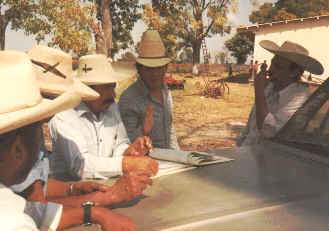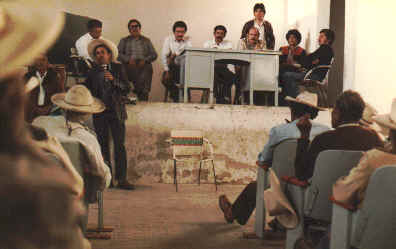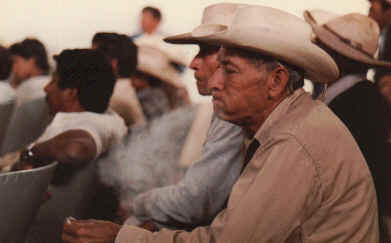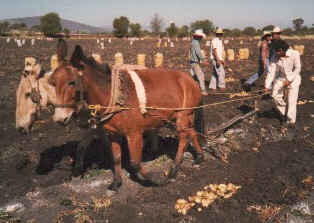 An inspector of the state credit bank, Banrural, discusses a matter with the elected authorities of the ejido.
An inspector of the state credit bank, Banrural, discusses a matter with the elected authorities of the ejido. An inspector of the state credit bank, Banrural, discusses a matter with the elected authorities of the ejido.
An inspector of the state credit bank, Banrural, discusses a matter with the elected authorities of the ejido.
The 1970s saw a major contraction of neolatifundist rental of ejidal land, as availability of cheap government supplied credit and a new support package for peasant farming encouraged many ejidatarios to return to the land. Many parcelas continued to be rented, especially those which were in the hands of old people whose children had emigrated permanently from the region or widows, who would sometimes prefer to rent than allow the land to pass to their own adult sons. As public employment and salaries increased, some ejido plots passed permanently into the hands of local professionals,doctors, teachers and agrarian bureaucrats,and increasing land values made buying into the ejidos increasingly difficult for ordinary U.S. migrants. The reconsolidation of the ejidos was therefore accompanied by new forces promoting the long-term dissolution of traditional peasant communities, and these forces were strengthened by an increasing peasant differentiation and land concentration in the hands of better-off families.
At the forefront of this buying up of ejidal land titles were the families of those who had acted as the peasant administrators of neolatifundios, who generally accumulated enough wealth in their own right to set up as entrepreneurs on their own account. But statization created other elements of an emergent ejido elite, in the form of ejidatarios who formed close relationships with agrarian officials, who were themselves interested in renting ejidal land and pursuing various other modes of private accumulation based on the illicit manipulation or theft of public resources. Technological transformation and investments in infrastructure put a premium on private investments in farm machinery and trucking and transport. Whatever the origins of their capital, a small group of "rich ejidatarios" and local entrepreneurs involved in these activities were main regional beneficiaries of the "modernization" which the state promoted. The Ciénega de Chapala provided a number of examples of how an alternative way of organizing modernization, on the basis of developing service cooperatives through which peasants could share collectively owned machinery and processing and marketing facilities, could be defeated by the close ties which developed between private sector interests and the agrarian bureaucracy.
What are first glance appears as a revival of peasant economy therefore turns out to be less substantial on closer inspection, and such a judgement is reinforced by other evidence. Firstly, the real returns from peasant farming were limited, especially for those who had no money of their own to supplement credits received from the government. Problems in the administration of the credit system, such as late delivery of money for performing specific tasks, fostered imperfect cultivation practices, which lowered yields. An index of the limitations of the new state-sponsored farming system is provided by the changing patterns of international migration. One might have expected those zones, like the Ciénega, which apparently benefited most from the new policies, to show lower rates of migration in the 1970s, but in fact the reverse is true. Credits and technological modernization did increase household incomes, but not enough to provide a living for the whole family: part of the increased income was therefore invested in sponsoring the international migration of one or more children.
Video Clip - Click on Quicktime Logo
![]() This clip shows the combine harvester purchased by the former neolatifundio administrator, Don Chema, working in a field of sorghum sown by one of the ejidatarios with credit from Banrural. Don Chema had been able to buy the machine with credit from a private bank, and it had been inherited by his widow on his death a few years before the scene was filmed. The profits from hiring the services of the combine were substantial in the early 1980s, and Chema's younger sons took responsibility for managing the asset for their mother. In the opening shot, we see the youngest son enjoying a cigarette in the cab of the truck which will transport the sorghum to a local grain merchant in the town of Sahuayo. (Super-8 movie footage transferred to video, no sound.)
This clip shows the combine harvester purchased by the former neolatifundio administrator, Don Chema, working in a field of sorghum sown by one of the ejidatarios with credit from Banrural. Don Chema had been able to buy the machine with credit from a private bank, and it had been inherited by his widow on his death a few years before the scene was filmed. The profits from hiring the services of the combine were substantial in the early 1980s, and Chema's younger sons took responsibility for managing the asset for their mother. In the opening shot, we see the youngest son enjoying a cigarette in the cab of the truck which will transport the sorghum to a local grain merchant in the town of Sahuayo. (Super-8 movie footage transferred to video, no sound.)


Officials from the Banrural Office in Jiquilpan preside over a ejido assembly at which the community's leader, the comisariado ejidal, is defending himself against charges of corruption at the annual rendering of accounts.

Some of the ejidatarios remain unimpressed.

One of the sons of the former administrator of the Yepes neolatifundio harvesting potatoes on one of the many plots in the ejido to which his father bought the rights (illegally) from another peasant.

Even the children of well-established and hard-working ejidatarios tended to become US migrants in the 1980s. Many parents sought social mobility for their children through investing in their education, but this strategy became less attractive as public sector professional salaries fell during the 1980s. Ramiro, on the left, abandoned university for a migrant career in Los Angeles. The man on the right, a non-migrant, is a primary school teacher.